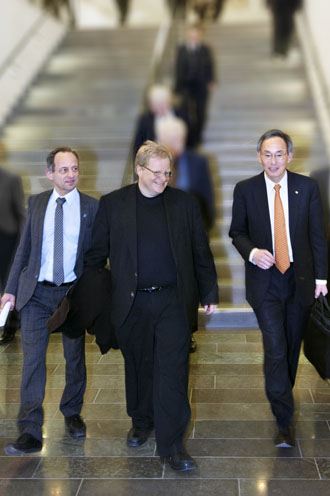U.S. Energy Secretary Visits KTH
Nobel laureate Steven Chu addresses researchers — and listens to students
NEWS
A University of California Professor, the 1997 Nobel Physics Prize winner and President Barack Obama’s Secretary of Energy paid a visit to KTH on December 8 — all in one person. Spending an afternoon on campus, Dr. Steven Chu delivered a scientific address Thursday and met students in a lab at the AlbaNova Centre for Physics, Astronomy and Biotechnology.

Taking a short break from the rigours of top-level American politics for a private trip to attend the 2011 Nobel Prize festivities in the Swedish capital, Professor Chu described his earlier work in quantum physics for an overflow crowd and met with three of the university’s PhD researchers in their laboratory.
Alternative energy and the threat of global warming were front-line issues for candidate Barack Obama in his 2008 campaign for the presidency. And he made it clear that scientific evidence, rather than party orthodoxy, would drive policy decisions in his administration. Professor Chu, with his hugely successful and entirely non-political career in research, was something of a surprise choice for energy secretary, but one that fit well with candidate Obama’s campaign promises.
Three years later, American commentators appear evenly divided on whether the administration is doing far too little or far too much to lessen the country’s dependence on foreign oil while reducing carbon dioxide emissions — a fact that might be taken as testament that the former director of the Lawrence Berkeley National Laboratory is serving his boss well, and might also partially explain why he and his wife Jean would welcome the opportunity to leave behind the policy wars in Washington for a few days to bask in a warm Swedish welcome during Nobel Prize week.
As a researcher, Dr. Chu studied the fundamentals of quantum physics, trapping and cooling atoms to extremely low temperatures — work that earned him the 1997 Nobel Prize in Physics together with William Phillips and Claude Cohen-Tannoudji. Since then he has explored methods to use these very cold atoms as “bouncing balls” in experiments designed to measure the gravitational constant to extreme precision.

From this earlier work in pure physics, he expanded his knowledge in biological physics and cell biology, helping to develop a variety of methods of super-resolution light microscopy. This was the subject of his talk at the AlbaNova Colloquium on campus at KTH.
“Imaging tissue cells and biofilms are among the most promising applications of this new tool,” he explained.
Super-resolution light microscopy refers to a variety of methods for achieving images with an optical microscope showing far better spatial resolution than the standard diffraction limit — typically more than 200 nanometers — imposed by the wavelength of visible light. By making very sensitive measurements of light emission from single fluorescent molecules, Dr. Chu and his fellow researchers localised the point of emission to a precision of less than a single nanometer.

Dr. Chu explained how his group at Lawrence Berkeley National Laboratory used these techniques to track various biochemical mechanisms, such as the chain of reactions that leads to cancer in a living cell. He talked about how the technique can be used to study the growth and life-cycle of biofilms, an area of great significance for applied science. Biofilms on the hull of a ship affect the energy efficiency of sea transport. On steel rails they can inhibit trains from stopping properly, and on organs or implants they can determine rejection or acceptance by the host.
Following the formal lecture, Dr. Chu visited students working in the related field of atomic force microscopes at the KTH Section of Nanostructure Physics. Post-doc student Erik Tholén and PhD candidates Daniel Platz and Daniel Forchheimer are conducting experiments using scanning probe instruments that oscillate harmonically over a sample surface to mechanically — rather than optically — reveal details down to the nano scale. “It’s like the difference between rubbing something with your finger and seeing it with your eyes. Both ways of examining the surface tell you something about it, but through different senses,” Platz explains.
The students’ research looks at nonlinear perturbations in these harmonic oscillators, work that they believe may lead to an increase the instrument’s resolution. “Professor Chu immediately saw the scientific value of understanding these perturbations,” Platz said. “I was just impressed that someone who works for the president of the United States would quickly grasp the theory and be able to comment on the experimental details.”
By Kevin Billinghurst; kb2@kth.se
Read about Intermodulation Products , a spin-off company based on research conducted at the KTH Section of Nanostructure Physics.

